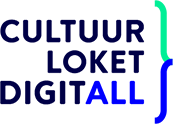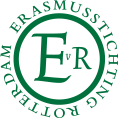Artikel
A review of Tuvia Ruebner’s photograph album, My Eyes Have Seen This Too
What does the picture see?
_w336.jpg)
2 januari 2012
What does the photograph see? How is the psychological world of the couple elucidated by their surroundings? The man’s waistcoat is too small for him, and the buttons gape; his dirty shirt peeks from underneath. There is also a tear in his trousers; something white shows through. These are external revelations of deep psychological wounds that cannot be described in words (especially not psychological terms), and that are expressed also in their faces and posture, as well as in the physical surroundings. These are metaphorical ‘wounds’, directed at the photographer and the viewer almost like the stigmata of crucifixion, inviting a penetrating gaze. (The photo reminds one of Caravaggio’s shocking painting Doubting Thomas, in which the saint inserts a finger into Jesus’ wound along with a sharp look.) The opening in the man’s clothing in the middle of his body is shaped like a vertical eye. It faces us right in the eye, while the eyes of the photographed man are almost hidden. This space becomes a “wound-eye”. It is white.
The shoes suspended above the woman’s head make a startling impression. They are polished (maybe the couple are cobblers?) and hang in the air, incongruously fine in the generally shabby context. The contrast between the condition of the shoes and the couple is stark: their own shoes are worn and dirty, but these shoes, almost an ethereal ‘ideal’ of shoes in the context of the photograph, remain spotless. These are someone else’s shoes, perhaps shoes for another time: shoes for the Sabbath that only one member of the couple can afford, sadly. The new shoes glance at the shoe hanging on the side – perhaps a sign indicating the profession of the shack dwellers. Between them stretches the gap between what exists and what lies beyond, possibly within reach but difficult to get to.
The shoe on the right suddenly represents someone walking away, out of the photo and toward the open area to the right. It hints at the possibility of ‘walking on air’ above the neighborhood of shacks, above the muddy ground. The number 68 above a photo entitled Afula, 1957 is suddenly a sign of the future, toward which the shoe is walking. The entire right wing of the house, made of a separate panel of tin, seems to want to go and cut itself off from the house. In contrast, again, there are the two pairs of shoes which are all earth, planted on the doorstep, stepping out for a moment from the rectangle of darkness behind the couple, doomed to return to it soon enough, when the photographer leaves. What does this photograph do? It agonisingly redeems this man and woman from the darkness of their cave; it sees a possibility of exit for them, the step suspended above their heads like a sign.
This kind of gaze recurs in many photographs in the book. It can be summed up as follows: Ruebner sees, in the fragment of world which he photographs, something happening between two elements in the picture – something which if the elements in the picture were to discern it, would be very significant for them. They do not see the analogy; the photo does. In a different photograph, shot in the artist Yossl Bergner’s studio in Tel Aviv (page 42), a group of angels made of wood and other materials stand next to a street sign of the “Elderly Workers’ Union of Tel Aviv”. In another photograph, Golan Heights 2005, a Druze fruit-seller sits by the roadside with crates of fruit. There is a plastic bottle upended in the top of a pipe stuck in the ground next to him. The entire photograph thus becomes a picture of an hourglass, of emptying. But the seller cannot see the bottle. The photograph seems to be telling him “get up, time is running out for you”. Actually, it is telling us. This article was first published in Hebrew in the Haaretz Books Supplement on 7 October 2007.
Image © Tuvia Ruebner. Reproduced here with kind permission of the photographer.
There is nothing extraordinary about photographs taken by poets, because, fundamentally, every artistic photograph is snapped by a kind of poet. Many photographs may be discussed in terms of metaphors, images and visual symbols, a fact especially apparent in the photographs by Ruebner, a poet who is also an excellent photographer.
It is difficult to write about a book of photographs without actually showing them to the reader. I will focus on a single picture, and make a few general remarks at the end. In the photograph I have chosen an elderly couple stands in the doorway of a shack in Afula [a town in northern Israel], in 1957. The hut bears the number 68, probably part of the address. Above the woman’s head hangs a pair of shoes, and another, single shoe is hung at the end of the shack, next to the “68”. The man, perhaps a new immigrant from Europe, is dressed in a three-piece suit. But the suit is torn and dirty, and the man rests his hand on the belt buckle as though to prevent the trousers from falling down; there is something dog-like about him. What does the photograph see? How is the psychological world of the couple elucidated by their surroundings? The man’s waistcoat is too small for him, and the buttons gape; his dirty shirt peeks from underneath. There is also a tear in his trousers; something white shows through. These are external revelations of deep psychological wounds that cannot be described in words (especially not psychological terms), and that are expressed also in their faces and posture, as well as in the physical surroundings. These are metaphorical ‘wounds’, directed at the photographer and the viewer almost like the stigmata of crucifixion, inviting a penetrating gaze. (The photo reminds one of Caravaggio’s shocking painting Doubting Thomas, in which the saint inserts a finger into Jesus’ wound along with a sharp look.) The opening in the man’s clothing in the middle of his body is shaped like a vertical eye. It faces us right in the eye, while the eyes of the photographed man are almost hidden. This space becomes a “wound-eye”. It is white.
The shoes suspended above the woman’s head make a startling impression. They are polished (maybe the couple are cobblers?) and hang in the air, incongruously fine in the generally shabby context. The contrast between the condition of the shoes and the couple is stark: their own shoes are worn and dirty, but these shoes, almost an ethereal ‘ideal’ of shoes in the context of the photograph, remain spotless. These are someone else’s shoes, perhaps shoes for another time: shoes for the Sabbath that only one member of the couple can afford, sadly. The new shoes glance at the shoe hanging on the side – perhaps a sign indicating the profession of the shack dwellers. Between them stretches the gap between what exists and what lies beyond, possibly within reach but difficult to get to.
The shoe on the right suddenly represents someone walking away, out of the photo and toward the open area to the right. It hints at the possibility of ‘walking on air’ above the neighborhood of shacks, above the muddy ground. The number 68 above a photo entitled Afula, 1957 is suddenly a sign of the future, toward which the shoe is walking. The entire right wing of the house, made of a separate panel of tin, seems to want to go and cut itself off from the house. In contrast, again, there are the two pairs of shoes which are all earth, planted on the doorstep, stepping out for a moment from the rectangle of darkness behind the couple, doomed to return to it soon enough, when the photographer leaves. What does this photograph do? It agonisingly redeems this man and woman from the darkness of their cave; it sees a possibility of exit for them, the step suspended above their heads like a sign.
This kind of gaze recurs in many photographs in the book. It can be summed up as follows: Ruebner sees, in the fragment of world which he photographs, something happening between two elements in the picture – something which if the elements in the picture were to discern it, would be very significant for them. They do not see the analogy; the photo does. In a different photograph, shot in the artist Yossl Bergner’s studio in Tel Aviv (page 42), a group of angels made of wood and other materials stand next to a street sign of the “Elderly Workers’ Union of Tel Aviv”. In another photograph, Golan Heights 2005, a Druze fruit-seller sits by the roadside with crates of fruit. There is a plastic bottle upended in the top of a pipe stuck in the ground next to him. The entire photograph thus becomes a picture of an hourglass, of emptying. But the seller cannot see the bottle. The photograph seems to be telling him “get up, time is running out for you”. Actually, it is telling us. This article was first published in Hebrew in the Haaretz Books Supplement on 7 October 2007.
Image © Tuvia Ruebner. Reproduced here with kind permission of the photographer.
© Dror Burstein
Vertaler: Rebecca Gillis
Bron: Haaretz, 7 October 2007
Sponsors
























